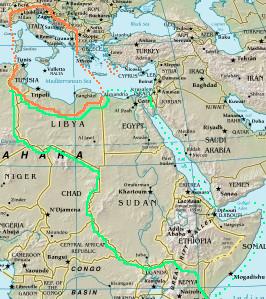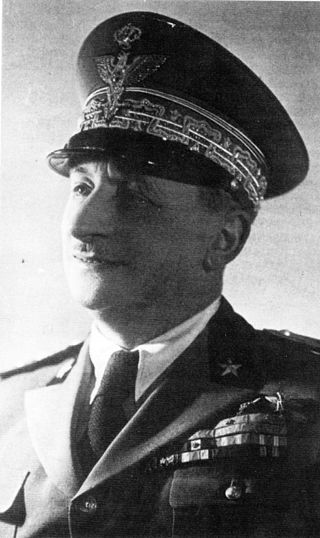
Ubaldo Soddu was an Italian general and politician who held the position of Deputy Chief of Staff of the Army and Undersecretary of State for War during the initial phases of World War II. On 13 June 1940, immediately after the outbreak of hostilities with France and the United Kingdom, he assumed the position of deputy chief of the General Staff. Promoted to army general, he replaced general Sebastiano Visconti Prasca as commander of the Albanian Higher Troop Command during the Greco-Italian War on 8 November 1940. Because of the defeat Italian troops suffered between 22 and 23 November 1940, he was replaced after four weeks in command by the Italian Royal Army's chief of staff, General Ugo Cavallero.
The Italian guerrilla war in Ethiopia was a conflict fought from the summer of 1941 to the autumn of 1943 by remnants of Italian troops in Ethiopia and Somalia, in a short-lived attempt to re-establish Italian East Africa. The guerrilla campaign was fought following the Italian defeat in the East African Campaign of World War II, while the war was still raging in Northern Africa and Europe.
The Gold Medal of Military Valor is an Italian medal established on 21 May 1793 by King Victor Amadeus III of Sardinia for deeds of outstanding gallantry in war by junior officers and soldiers.

Imperialism, colonialism and irredentism played an important role in the foreign policy of Fascist Italy. Among the regime's goals were the acquisition of territory considered historically Italian in France and Yugoslavia, the expansion of Italy's sphere of influence into the Balkans and the acquisition of more colonies in Africa. The pacification of Libya (1923–32), the invasion of Ethiopia (1935–36), the invasion of Albania (1939), the invasion of France (1940), the invasion of Greece (1940–41) and the invasion of Yugoslavia (1941) were all undertaken in part to add to Italy's national space. According to historian Patrick Bernhard, Fascist Italian imperialism under Benito Mussolini, particularly in Africa, served as a model for the much more famous expansionism of Nazi Germany in Eastern Europe.
This is a list of words, terms, concepts, and slogans in the Italian language and Latin language which were specifically used in Fascist Italian monarchy and Italian Social Republic.

The Pistoia Brazilian war cemetery is a former Second World War cemetery located in Pistoia, Toscana, Italy. The cemetery site honors Brazilian soldiers who died in Italy during World War II, the remains of whom were buried here until 1960.

The Asiago War Memorial is a World War I memorial located in the town of Asiago in the Province of Vicenza in the Veneto region of northeast Italy. Surrounded by mountains that were the site of several World War I battles, the monument houses the remains of over 50,000 Italian and Austro-Hungarian soldiers and is a popular destination for travelers to the region. In Italian the memorial is typically called Sacrario Militare di Asiago or Sacrario Militare del Leiten. Leiten is the name of the hill on which the memorial sits.

Sacrario militare di Pocol is a cemetery and shrine near the Falzarego Pass, in the locality of Pocol in the comune of Cortina d'Ampezzo in the Veneto region of northern Italy. The small church and cemetery were built in 1916 as a military cemetery by the 5th Alpine group. A shrine was built in 1935 as memorial to the thousands who died during World War I on the Dolomite front. It is a massive square tower of stone, clearly visible from the entire Ampezzo valley below. The remains of 9,707 Italian soldiers and 37 Austro-Hungarian soldiers are buried in the shrine. In a crypt in the centre of the structure rests the body of general Antonio Cantore, who was awarded the gold medal for military valor.

Cesare Amè was an Italian general and intelligence officer, chief of the Servizio Informazioni Militare from 1940 to 1943.

Vittorio Tur was an Italian admiral during World War II.

The Redipuglia War Memorial is a World War I memorial located on the Karst Plateau near the village of Fogliano Redipuglia, in the Friuli Venezia Giulia region of northeastern Italy. It is the largest war memorial in Italy and one of the largest in the world, housing the remains of 100,187 Italian soldiers killed between 1915 and 1917 in the eleven battles fought on the Karst and Isonzo front.

The German Futa Pass Cemetery is Italy's largest war cemetery. According to the German War Graves Commission it holds remains of 30,800 German soldiers who died in the Second World War. It is located at the summit of the Futa Pass in the Apennines and in Mugello, near Traversa in the commune of Firenzuola, that is, about 40 kilometers north of Florence and 40 kilometers south of Bologna along National Highway Nr. 65 near the border of Tuscany and Emilia-Romagna.
Formia War Memorial is an Italian war memorial erected in 1926 to commemorate the dead of the First World War and earlier conflicts. It stands in the Piazza della Vittoria, in the centre of Formia, a town on the coast of the Province of Latina beside the Tyrrhenian Sea, about 150 km (93 mi) southeast of Rome and 100 km (62 mi) northwest of Naples

The bombing of Padua was a series of attacks by the United States Army Air Force and the Royal Air Force on the Italian city of Padua, Veneto, during World War II. These raids were aimed at disabling Padua's marshalling yard, but also resulted in heavy damage to the city and civilian casualties.

The military memorial of Monte Grappa is the largest Italian military ossuary of the First World War. It is located on the summit of Monte Grappa between the provinces of Treviso and Vicenza, at 1,776 meters above sea level. Access to the memorial is via the Strada Cadorna, built by the army on the orders of General Luigi Cadorna to bring construction materials for the fortification on Monte Grappa in 1917.

The Oslavia War Memorial is an Italian monument to soldiers who fell in battle during the battles of the Isonzo, particularly those who died during the taking of Gorizia in 1916. It stands on a 150m hill in the village of Oslavia, on the outskirts of Gorizia. The hilltop was on the front line as Austro-Hungarian troops defended the salient around Gorizia during the first, third and fourth battles of the Isonzo.

Ezio Rosi was an Italian general during World War II. He commanded the Sixth Army from 1941 to 1943, and after a brief period as Army Chief of Staff, he assumed command of Army Group East in 1943.

Giuseppe Amico was an Italian general during World War II.
Alberto Mannerini was an Italian general during World War II. After the war he served as Commander-General of the Carabinieri from 1950 to 1954.

La Voce della Patria was an Italian-language weekly newspaper published in Berlin from 1943 to 1944. It was an organ of the Republican Fascists Abroad and Overseas, published by the Italian Social Republic (RSI) Berlin embassy for distributed in camps of Italian Military Internees (IMI) in Germany following the September 3, 1943 armistice between the Kingdom of Italy and the Allied powers.














